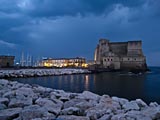Naples
 Naples is located halfway between the volcano Vesuvius and the separate volcanic
area, the Phlegrean Fields. It is an enchanting and moving city. It is unique and
different. A lot of symbols of Italy abroad were born here, as for example the pizza,
the pasta, the ragù (tomato sauce with veal or pork requiring 5-6 hours cooking
time), the unique ricotta-based pastiera, the babà, the tarantella, the Neapolitan
mask Pulcinella, the Neapolitan songs, the Neapolitan theatre, the typical Neapolitan
comic spirit.
Naples is located halfway between the volcano Vesuvius and the separate volcanic
area, the Phlegrean Fields. It is an enchanting and moving city. It is unique and
different. A lot of symbols of Italy abroad were born here, as for example the pizza,
the pasta, the ragù (tomato sauce with veal or pork requiring 5-6 hours cooking
time), the unique ricotta-based pastiera, the babà, the tarantella, the Neapolitan
mask Pulcinella, the Neapolitan songs, the Neapolitan theatre, the typical Neapolitan
comic spirit.
Founded by the Greeks, and therefore with a millenary history, Naples was the capital
of southern Italy and Sicily for eight centuries - the greatest pre-unitary Italian
state ever - and became a reference point for the entire European culture. Its past
is visible in its architecture (its town centre is on UNESCO's World heritage list),
but also in all its vernacular idioms, cuisine, music, handicrafts and theatre.
Its town centre is quite large (the biggest in Europe), and so rich (in the 1700s,
Naples had something like 500 cupolas, although today there are approximately 100
less due to the World War II bombings: it is still the city with the greatest number
of monumental churches in the world), making it fascinating to get lost in it; people
are enraptured by the alleys of its popular districts, the outlines of its historic
palaces and the numerous signs of religious devotion, all in a Baroque style.
If the Caracciolo seafront and Via Partenope are the main places people from Naples
go for walks (up to Ovo castle), then piazza Plebiscito is the throbbing heart of
the city and a place where locals gather: overlooking the square is the Royal Palace,
the heart of power in Naples since the 1600s. Behind it is Nuovo castle, better
known as the Maschio Angioino, which dominates Town Hall square.
Behind Town Hall is Via Toledo, to the west of which is the labyrinth of the Spanish
Districts, otherwise known as the "purest Neapolitan" areas in the city.
As is the adjacent Spaccanapoli, one of the districts with the most churches: among
others, Santa Chiara with its annexed Clarisse cloister, realized in the 1300s.
Next to San Lorenzo Maggiore (also frequented by Boccaccio, while Petrarch lived
in the annexed convent) is Via dei Tribunali, which intersects with Via del Cathedral:
erected in a place where there has always been a place of worship right from the
4th Century, the Cathedral was subjected to subsequent restoration and remodeling.
Its doorways date back to the 1400s, and inside is the church of Santa Restituta,
one of the early Christian basilicas on which it is set. Vomero hill, a city within
the city, dominates the city's historic districts from above.
Certainly the museums enriching Naples cannot be overlooked, starting with the National
Archaeological Museum and the Reggia di Capodimonte, on the hill, home to a wonderful
porcelain collection. Visitors must also make a stop at the Girolamini monastery,
St. Peter's music conservatory in Maiella, Pio Monte della Misericordia (with its
famous art gallery), and the San Several chapel in which the mysterious statue of
the veiled Christ is kept.
There is an extraordinary but little-known side of Naples. It is Naples underground.
Starting in piazza San Gaetano (dedicated to one of the 54 patron saints of the
city), visitors are led 40 m underground along a guided tour through old underground
cisterns dating back to the Greek-Roman period and active up to the 1800s: Naples
was in fact the only large European city to have drinking water in its homes, supplied
by a system of wells connected to underground-aqueduct cisterns, which were obtained
by digging in the tuff: today, one kilometre (of the tens of kilometres under the
city) of the galleries can be visited. The old, underground Greek-Roman theatre
can also be visited.
The San Gennaro catacombs should also be visited, in the bowels of the city; this
burial complex is the most important in southern Italy both for its age (they date
back to the 2nd Century) and its frescoes dating back to the 10th Century. Here
is a little something about Gennaro, the patron saint par excellence: his blood
was collected in an ampoule and three times a year in the Cathedral (19th September,
the Saturday before the first Sunday in May and 16th December), the "miracle"
of blood takes place, when the blood liquefies and then coagulates again.
By: Italia Lifestyle Locali d'Autore
- Every reproduction of texts, images or anything else here published is forbidden.
Every unauthorized reproduction does not follow italian law # 633/41.